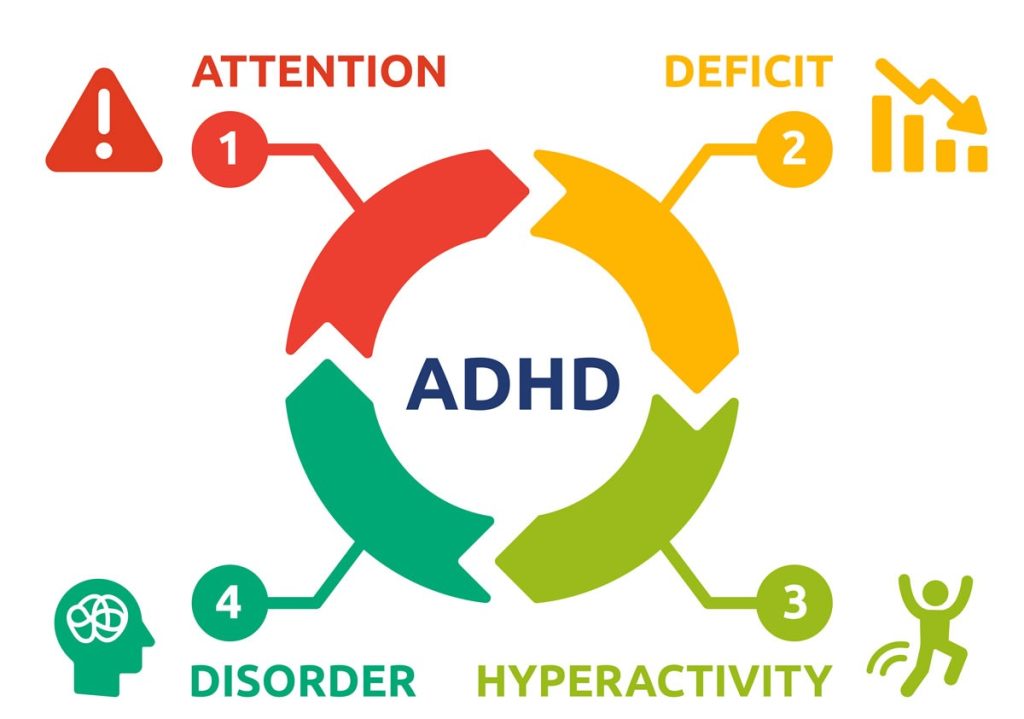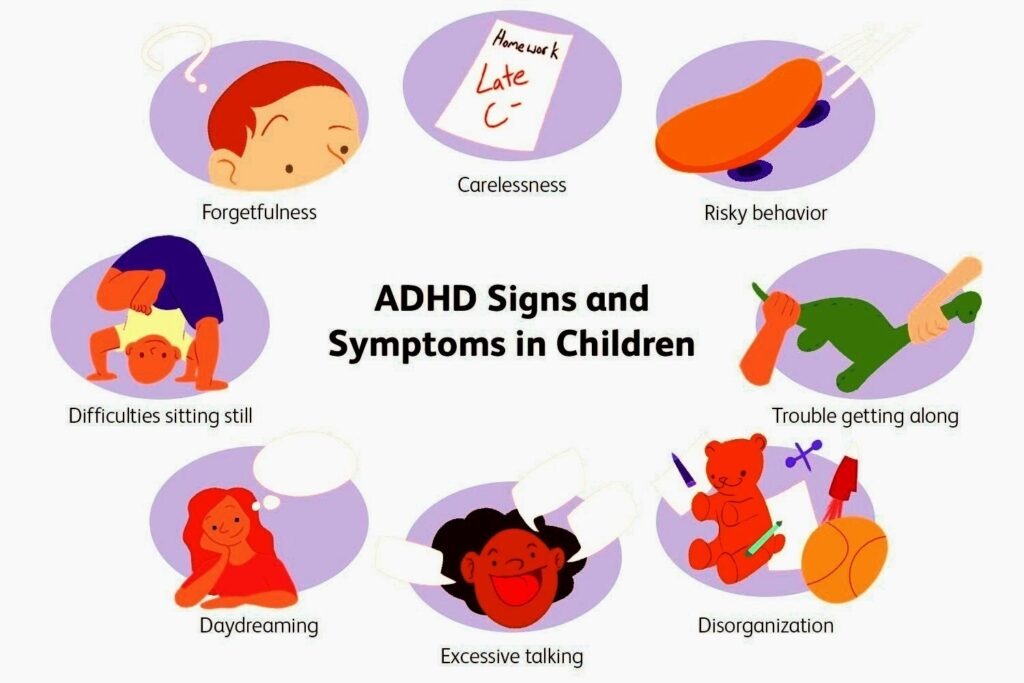The neurodevelopmental disorder known as attention deficit hyperactivity disorder (ADHD) is typified by executive dysfunction leading to excessive and pervasive symptoms of inattention, hyperactivity, impulsivity, and emotional dysregulation that are developmental inappropriate and impairing in multiple contexts.

ADHD symptoms are typically first identified at a young age and may intensify as a child’s environment changes, such as when they enter school.
The majority of instances are identified in children under the age of twelve, while occasionally it is discovered later in childhood.
CAUSES
Although the precise origin of ADHD is uncertain, family history of the disorder has been documented.
There is proof that children with ADHD have brains that are anatomically different from those of children without the disorder. For example, children with ADHD show distinct brain area activation during specific tasks and have lower volume of both grey and white brain matter.
Additional research has revealed that ADHD is associated with abnormalities in the brain’s frontal lobes, caudate nucleus, and cerebellar vermis. The condition has also been related to a number of non-genetic variables, including low birth weight, early birth, exposure to toxins (smoke, alcohol, lead, etc.) during pregnancy, and high levels of stress.
SYMPTOMS

There are three main types of ADHD:
* Predominantly inattentive presentation.
The term “inattentive” describes problems with organization, focus, and staying on task. Six (or five for those who are 17 years of age or older) of the following symptoms must regularly occur in order to be diagnosed with this kind of ADHD:
- Disregards directions and fails to finish jobs, chores, or schooling (may begin tasks but loses attention easily).
2. Lacks attention to detail and carelessly completes assignments for work or education.
3. Forgets to do everyday duties like errands and chores. It is common for older individuals and teens to forget to make appointments, pay bills, and return calls.
4. Has trouble maintaining concentration on jobs or activities, such as lengthy readings, lectures, or conversations.
seeming not to hear when someone speaks to them.
5. Avoids or detests doing anything that call for prolonged mental work, including filling out forms and writing reports.
6. Is easily distracted.
7. Frequently misplaces items that are necessary for daily living or tasks, including books, school papers, wallets, cell phones, and spectacles.
* Predominantly hyperactive/impulsive presentation.
Excessive movement, including fidgeting, having too much energy, moving about a lot, and talking a lot, is referred to as hyperactivity. Impulsivity is the term used to describe choices or acts made without considering the repercussions. Six (or five for those who are 17 years of age or older) of the following symptoms must regularly occur in order to be diagnosed with this kind of ADHD:
- Talks too much.
2. Wriggles in the seat, fidgets with hands or feet, or taps them.
3. Interferes with or bothers other people.
4. Unable to remain seated (at work or in a school).
5. Runs around or climbs in places that are not suitable.
6. Finds it difficult to wait for their turn, for example, when standing in line.
7. Unable to play or engage in calm leisure activities.
8. Always “on the go,” as if driven by a motor.
9. Blurts out an answer before a question has been finished.

* Combined presentation.
This type of ADHD is diagnosed when both criteria for both inattentive and hyperactive/impulse types are met.
It is crucial to remember that a number of illnesses, including learning disabilities, mental disorders, anxiety, substance abuse, head trauma, thyroid issues, and the use of certain drugs, including steroids, can resemble ADHD. ADHD may also co-exist with other mental health conditions, such as oppositional defiant disorder or conduct disorder, anxiety disorders, and learning disorders.
Boys are diagnosed with ADHD more frequently than girls. Girls are less likely to exhibit disruptive behavior that highlights the symptoms of ADHD and are more likely to experience inattentiveness-only symptoms. It follows that girls with ADHD would not always receive a diagnosis.
SIGNS

A child with ADHD might:
* Find it difficult to avoid temptation.
* Daydream a lot.
* Forget or lose things a lot.
* Find it difficult to accept shifts.
* Have trouble getting along with other people.
* Forget or misplace items.
* Many tremble or fidget.
* Talk too much.
TREATMENT
Behavior therapy, including training for parents; and Medications:
– Stimulants
– Non-stimulants
Treatment suggestions:
For children with ADHD younger than 6 years of age, Prior to attempting medication, the American Academy of Pediatrics (AAP) advises parents to receive training in behavior management.
For children 6 years of age and older, Together, medication and behavior treatment are advised, as well as parent education on behavior management for kids up to age 12 and various forms of behavior therapy and training for teenagers. Schools may also be included in the course of care. Adding behavioral classroom intervention and school supports is another recommendation made by the AAP.
Parental advice on behavior management:
* Manage distractions.
* Create a routine.
* Assist your kid with planning.
* Restrict options.
* Use goals and praise or other rewards.
* Encourage a healthy way of living.
* Whenever you speak with your child, be precise and unambiguous.
* Create positive opportunities.
* Discipline effectively.
Medications
There are 5 types of medicine licensed for the treatment of ADHD:
* Guanfacine
* Methylphenidate
* Lisdexamfetamine
* Dexamfetamine
* Atomoxetine
While there is no long-term treatment for ADHD, these medications may improve concentration, reduce impulsivity, promote calmness, and facilitate the acquisition and application of new abilities.
Certain medications must be taken daily, while others are only required on school days. Periods of treatment are sometimes advised to determine whether the medication is still necessary.
Tips for parents
If you’re the parent of a child with ADHD:
1. Consider who else, like their school or daycare, should be aware of your child’s ADHD.
2. Making new friends at neighborhood support groups might help you cope and prevent feelings of isolation.
3. Make sure your doctor or other expert assists you in distinguishing between ADHD and any other issues your child may be experiencing.
4. Find out what to watch out for and the negative effects of any medications your child is taking.















Leave a comment